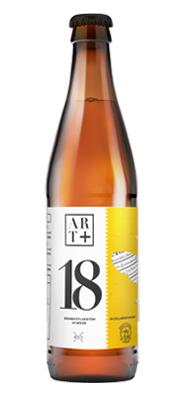 |
 |
ART+18 Honey and Coconut Wheat Wine
The strong, intense, and yeasty character of the Wheat Wine is balanced with lighter colour, subtler malty tones in contrast to Barley Wine or RIS.. |
Style
The Wheat Wine is our variation on the Barley Wine style having its origins in England. The first commercial beer of this style was brewed in the second half of the 19 th century although some argue that barley beer had been brewed as early as in Ancient Greece. We have taken a fresh perspective on this style. In contrast to barley wine, wheat wine differs in colour. It is much lighter and thus less intense in terms of malty aromas. As a result, the beer is subtler and the bouquet is dominated mostly by yeast tones and extra ingredients. The common ground is high alcohol contents, sweetness and moderate bitterness level.
Malts/extract:
Achieving such a high extract with the use of wheat malts is quite an achievement. Using mostly light malts produces uniquely light colour of the brew. This is the reason for subdued malty tones.
Hops:
We have used traditional, continental hops, Magnum to produce bitterness, and Hersbrucker, to produce flowery aromas that go well with strong, light beer. Whereas Wheat Wine leans more towards the malty side. That’s why, hopping is less intense.
Extra ingredients:
At the last stage of the production, the beer has been mixed with craft honey. The Honey and Coconut version contains canola honey, the first spring honey produced by bees after wintertime in the months of April and May when rape plants are in full bloom. The smell is long lasting and may last for few years while its subtle, mellow taste brings a clear touch of bitterness. After adding honey, the beer has been pasteurized to preserve its qualities.
Roasted coconut chips were added just before going through the HopGun to bring about the aromas of coconut copra just before bottling.
Ageing *
Such thick and intense beers age really well, similarly to good, strong wines. It is a great idea to store a few bottles and open them successively (every half a year every year) to experience its different taste. First, it is going to be quite fresh like a dessert wine. With time, it is going to obtain tones of sherry, white dry fruit (pear or light raisins) and mead. What an experience!
*If stored in proper conditions (temperature of about 10C, no sunlight), the beer will release refined tones produced by the oxidization process.
- Style: Wheat Wine
- Parameters
- Extract: 27,0%
- Alcohol: 10,0% obj.
- IBU: 60
- Ingredients:
- Malts: wheat, Pilsner, Caramel Pils
- Hops:
- Bitter: Hallertau Magnum (DE),
- Aromatic: Herbrucker (DE)
- Yeast strain: Danstar Nottingham
- Extra ingredients: craft acacia and canola honey; vanilla sticks
- Look: dark orange
- Aromas: honey, roasted coconut flakes, peaches, pineapple, mead, bananas
- Mouthfeel:
- Trick, oily, low saturation
- Sweet and sour, white fruit: pineapple, peach
- Warming, slight sourness and sweetness
- Serving temperature: 9-11°C
- Glass: Snifter, Tulip
- Foodpairing:
- Very intense and strong beer recommended with desserts only: Crème brûlée with gooseberry, rhubarb sorbet or strong cheese e.g. Łomnicki-type long-maturing goat cheese



